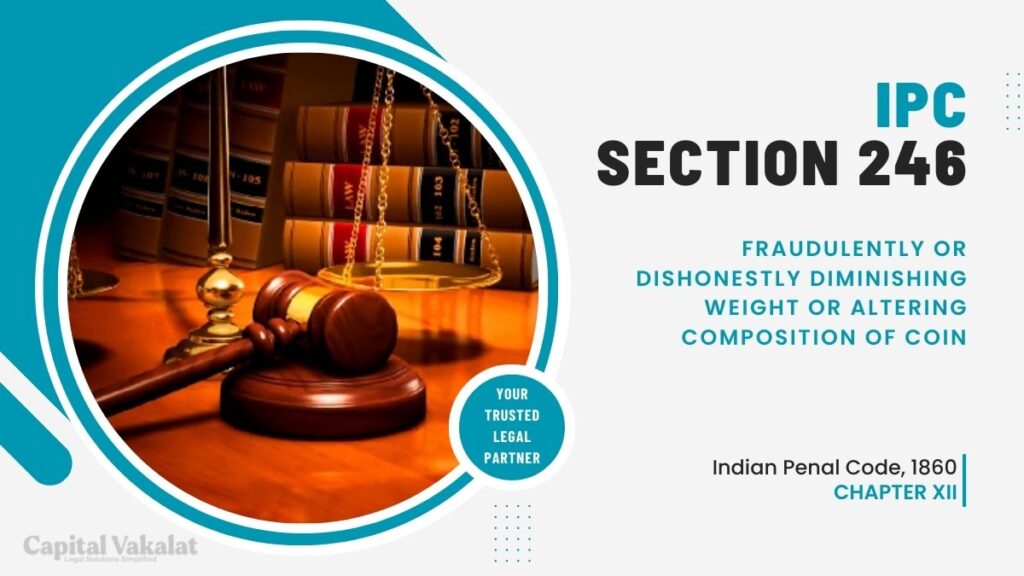Coins have been an essential medium of exchange throughout history, serving as a symbol of a nation’s economic stability and sovereignty. However, when individuals engage in activities that diminish the weight or alter the composition of coins with fraudulent or dishonest intent, it not only affects the economy but also violates the law.

In this article, we will delve into Section 246 of the Indian Penal Code (IPC), exploring the various facets of coin alteration, its implications, and the measures taken to combat it.
Introduction to Section 246 IPC
Section 246 of the IPC deals with the act of fraudulently or dishonestly diminishing the weight or altering the composition of a coin with the intention of deceiving or causing loss to another person. This legal provision aims to protect the integrity of currency and the trust people place in it.
Understanding Fraudulent Coin Alteration
Fraudulent coin alteration involves activities like shaving metal from the edges of coins, melting them to create counterfeit coins, or using chemicals to alter their appearance. These actions can result in coins having less intrinsic value than their face value, leading to economic repercussions.
Historical Perspective of Coin Alteration
Coin alteration is not a new phenomenon; it has existed for centuries. In ancient times, individuals would clip small pieces from coins to create new ones or melt them down for profit. Understanding this historical context provides insights into the evolution of laws surrounding coin integrity.
Legal Implications and Consequences
Engaging in fraudulent coin alteration is a criminal offense under Section 246 IPC. Offenders can face imprisonment and fines, reflecting the seriousness of such activities. Coin alteration not only compromises the economic system but also erodes public trust in currency.
Methods and Techniques of Coin Alteration
Coin alteration techniques have evolved over time. Some individuals use advanced technology and machinery to tamper with coins, making detection more challenging. Exploring these methods sheds light on the need for improved countermeasures.
Challenges Faced by Law Enforcement
Detecting coin alteration is a complex task for law enforcement agencies. Perpetrators continuously adapt to new methods, making it vital for authorities to stay ahead in the race to protect coin integrity.
Real-Life Cases and Examples
Highlighting real-life cases where coin alteration has been detected and prosecuted can illustrate the gravity of the issue. Sharing such examples can serve as a deterrent for potential offenders.
The Importance of Protecting Coin Integrity
Protecting the integrity of coins is essential for maintaining trust in the monetary system. When citizens believe that their currency is secure, it promotes financial stability and encourages economic growth.
Combating Coin Alteration in the Digital Age
In today’s digital age, technology plays a significant role in both coin alteration and its prevention. Enhanced security features on coins, along with digital tracking and monitoring, have become essential tools in the fight against coin alteration.
Conclusion
In conclusion, Section 246 IPC serves as a critical safeguard against fraudulent and dishonest coin alteration, reflecting the significance of maintaining the integrity of currency. As we move into an increasingly digital age, it is vital to adapt and strengthen measures to protect coins from being tampered with. By doing so, we can ensure a more secure and stable economic environment.
Frequently Asked Questions
How have methods of coin alteration evolved over time?
Coin alteration techniques have become more sophisticated, incorporating advanced technology and machinery.
Why is it important to protect the integrity of coins?
Coin integrity is crucial for maintaining public trust in the monetary system and fostering economic stability.
What challenges do law enforcement agencies face in detecting coin alteration?
Perpetrators continually adapt to new methods, making detection a complex task.
How has technology influenced the fight against coin alteration in the digital age?
Technology has enabled enhanced security features on coins and digital tracking to combat coin alteration effectively.